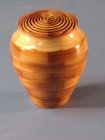I've been turning with a Talon chuck for years and never had a problem. Every so often I think about upgrading to a Stronghold. Other than the larger size and extra mass, what's the difference?
Also when turning larger bowls, 10"- 14", I noticed I get a lot of noise/chatter on the second turning on the inside of a twice turned bowl. I am wondering if the extra mass of the Stronghold chuck will absorb some of the noise?
Thanks
Also when turning larger bowls, 10"- 14", I noticed I get a lot of noise/chatter on the second turning on the inside of a twice turned bowl. I am wondering if the extra mass of the Stronghold chuck will absorb some of the noise?
Thanks



